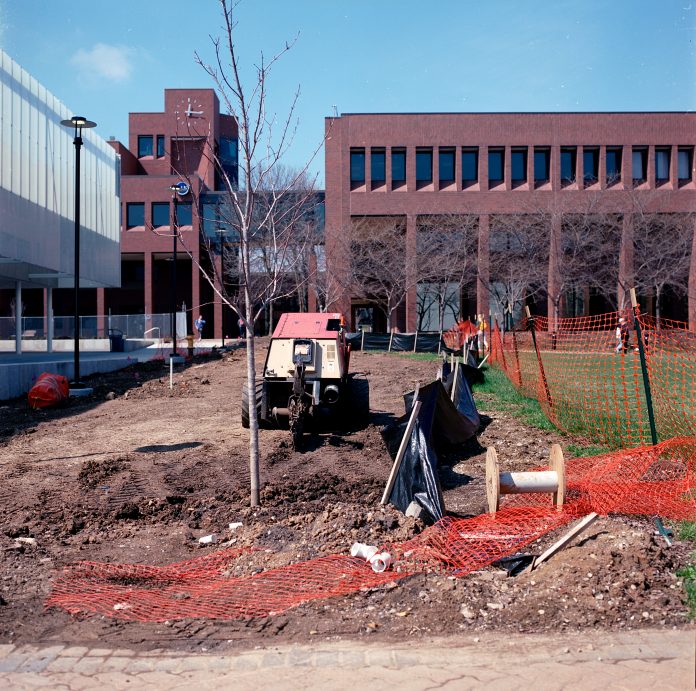Daniel Moreira
Managing editor
Spring Construction Slated- Published fall 1979
In January 1970 construction equipment rolled into a farming area and started moving earth, pouring concrete and stacking bricks.
Johnson County’s Community College was on its way to acquiring a new campus. This spring, ten years later, construction equipment will again roll into the drives off Quivira Road and College Blvd in order to build JCCC’s new Arts and Technology Building.
“We can look forward to groundbreaking as soon as the ground thaws in the spring and opening for classes in fall 1981,” said John Cleek, college president
After the Board of Trustees approved a contract with Perkins and Will of Chicago for architectural services for the $3.4 million Arts and Technology Building and $70,000 in remodeling projects to the existing campus.
Construction of the new building will include space for all programs originally approved by the Board in the educational specifications. New programs which will be offered as a result of the additional 57,000 square feet of space planning for the building include automatic technology, construction and maintenance technology and climate control technology.
Also contained in the new building will be space for JCCC’s art programs, including drawing and painting, photography, ceramics, sculpture and silversmithing.
The $70,000 remodeling project included in the plan will double available space in the present commercial art facilities and expand faculty and staff office space.
Also, additional classroom space will be provided. Relocation of the music area and a gallery space will be created with the remodeling of present facilities.
Although the Perkins and Will Group of Chicago will execute the basic design of the new building, basic design of the new building, Midgley, Shaughnessy, Fickel and Scott of Kansas City will oversee the actual construction.
Everlasting Expansion- Published Spring 2019
What began as classes scattered around Merriam in 1969 eventually became what we know today — Johnson County Community College.
After its start in 1969, the college acquired a permanent campus in the fall of 1972. Back then, the college had only six buildings; now, with the addition of the Fine Arts & Design Studio (FADS) and the Career and Technical Center (CTEC), the campus has a total of 24 buildings.
Until 1972, the college did not have an official, permanent campus. According to Charles Bishop, author of “The Community’s College: A History of Johnson County Community College, 1969-1999,” in 1969, the college’s classes were rooted in Merriam Elementary School and the Johnson County Airport for the Aviation Institute, as well as in other parts of the city.
The plan to construct a campus began in 1969, when county residents voted for the approval of $12.9 million in general obligation bonds to purchase more than 200 acres in Overland Park. Those acres, three years later, became what we know today as the college.
By 1972, the first six buildings of the college had been constructed. Back then, they were known as General Classroom Building (now the General Education Building, GEB), Educational Media Center (now the Billington Library, LIB), Science and Technology Building (now the Science Building, SCI), Central Services (now the Campus Services Building, CSB), Physical Development (now the Gymnasium, GYM) and the College Commons Building (COM).
Now, nearly 50 years later, the campus is hatching two new buildings. Barbara Larson, Executive Vice President of finance and administration services, talked about current plans for the future of the campus. “
We completed this facility’s master plan in 2016, so the work that we are doing now will be finished in about a year,” Larson said. “[One of the goals] is working toward complete solar rooftops on all of our buildings. By the time we finish the [FADS and CTEC buildings], we will have solar on six buildings. The goal is to have them on 100 percent of our buildings, and we are continuing to budget for solar installations every year.”
According to Larson, one of the college’s main motivations is to make the buildings on campus more sustainable. One goal of the campus is to continue achieving high marks in Leadership in Energy and Environmental Design, or LEED. LEED is a green building rating system which is used across the globe. The status is granted at different levels, going from certified (most basic), to silver, gold or platinum (most prestigious).
“A goal that we have is that all new construction is built to LEED silver,” Larson said. “The Galileo’s Pavilion (GP) is a platinum, which is very hard to achieve. We are hoping that one of these buildings might even have enough points to be even gold. We would love that.”
With the CTEC and FADS buildings emerging from the clouds of dust, metallic noise and orange fencing of their respective construction sites, Larson talked about how important being eco-friendly is to the campus.
“We are interested in continuing to modernize and improve the facilities that we have,” Larson said. “Our sustainability goals really drive how we work to improve our buildings.”
Looking back at the 50 years of the college, the once six building-campus is on its way to more sustainable energy and environmentally certified buildings, a long way forward from the original 1972 Johnson County Community College.
This story was featured in our 50th anniversary edition.






















